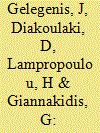|
|
|
Sort Order |
|
|
|
Items / Page
|
|
|
|
|
|
|
| Srl | Item |
| 1 |
ID:
181762


|
|
|
|
|
| Summary/Abstract |
Energy Performance Certificates (EPCs) and EPC digital registers are key tools to evaluate different aspects of the building stock and its energy consumption. This paper presents several detailed energy performance evaluations on the Italian buildings based on a sample of over 2,000,000 EPCs extracted from the national EPC register (SIAPE), contributing to the definition of an updated energy performance baseline of the Italian building stock. This is the first work using the Italian EPC register to define such a baseline to the extent of the authors’ knowledge. Furthermore, combined analyses of EPC data were carried out to obtain information on the influence of the Italian energy regulations on building characteristics and on the effectiveness of energy strategy application for building renovation.
|
|
|
|
|
|
|
|
|
|
|
|
|
|
|
|
| 2 |
ID:
150446


|
|
|
|
|
| Summary/Abstract |
This paper investigates the effect of Energy Performance Certificate (EPC) ratings on residential prices in Wales. Drawing on a sample of approximately 192,000 transactions, the capitalisation of energy efficiency ratings into house prices is investigated using two approaches. The first adopts a cross-sectional framework to investigate the effect of EPC rating on price. The second approach applies a repeat-sales methodology to investigate the impact of EPC rating on house price appreciation. Statistically significant positive price premiums are estimated for dwellings in EPC bands A/B (12.8%) and C (3.5%) compared to houses in band D. For dwellings in band E (−3.6%) and F (−6.5%) there are statistically significant discounts. Such effects may not be the result of energy performance alone. In addition to energy cost differences, the price effect may be due to additional benefits of energy efficient features. An analysis of the private rental segment reveals that, in contrast to the general market, low-EPC rated dwellings were not traded at a significant discount. This suggests different implicit prices of potential energy savings for landlords and owner-occupiers.
|
|
|
|
|
|
|
|
|
|
|
|
|
|
|
|
| 3 |
ID:
128415


|
|
|
|
|
| Publication |
2014.
|
| Summary/Abstract |
All European Union Member States require an Energy Performance Certificate (EPC) when buildings are constructed, sold and rented. At its introduction the EPC was considered a pioneering instrument, one that would help overcome an information deficit hindering consumer interest in energy efficient dwellings. Now that the EPC has been implemented for several years it is possible to examine its impact. This research draws on data from ex-ante and ex-post assessments of the EPC in a number of countries and presents the results of a survey of Dutch private dwelling purchasers. This survey was based on two sample populations, one received an EPC during property transaction and another did not. Differences were sought between the two samples in a number of areas relating to the adoption of energy efficiency measures. Results show that many projections about the impact of the EPC have fallen short. The EPC was found to have a weak influence, especially pre-purchase. The potential of the EPC in driving energy efficiency improvement in the existing stock is doubted especially if it continues to act independent from a mix of instruments designed to tackle multiple barriers. It is argued that the energy saving potential of existing dwellings, applauded in climate change policy, will remain unexploited if it continues to be assessed subjectively by householders.
|
|
|
|
|
|
|
|
|
|
|
|
|
|
|
|
| 4 |
ID:
150902


|
|
|
|
|
| Summary/Abstract |
Energy labels have generally received positive response from consumers and have moved the market for white goods and cars in the direction of more energy-efficient products. On the real estate market, it was expected that an energy label, rating the energy performance of a property based on a national energy performance certificate (EPC) might receive similar response. However, in Denmark no response to the energy performance rating was observed for 15 years. This was a surprise considering that Denmark was the first country to implement an A to G rating of the energy performance of buildings. A statistical examination of data on property sales prices and energy performance ratings was carried out. All relevant property transaction data from 2007 till 2012 were examined and they showed that energy performance ratings had an impact on property sales prices. However, before June 2010, the impact was modest, whereas after June 2010 the impact of energy performance ratings on property sales prices increased significantly as a result of an EU requirement to display the energy performance rating in connection with property sales. On this background, it was concluded that a public display of the energy performance rating is fundamental for market response.
|
|
|
|
|
|
|
|
|
|
|
|
|
|
|
|
| 5 |
ID:
128337


|
|
|
|
|
| Publication |
2014.
|
| Summary/Abstract |
The building sector in Greece presents a huge energy saving potential, the largest part of which is remaining unexploited. The recently enacted legislation for the energy performance of buildings, in combination with the financial support provided by funding programmes to low income families is expected to significantly boost the deployment of energy efficient technologies in the Greek domestic sector. The exploitation of these legal and financial instruments follows a formalised process of energy audits, resulting in buildings classification and in the submission of Energy Performance Certificates (EPCs) including suggestions to improve the dwellings' energy performance. The paper aims at an ex-ante evaluation of the market trends revealed by EPCs in Greece, in order to identify the perspectives of individual technologies and to assess the degree to which the certification procedure helps in improving the energy performance of buildings. The results indicate a strong trend towards less cost-effective technologies, revealing a sub-optimal allocation of financial resources and putting into risk the path towards the achievement of EU targets for 2020.
|
|
|
|
|
|
|
|
|
|
|
|
|
|
|
|
| 6 |
ID:
094222


|
|
|
|
|
| Publication |
2010.
|
| Summary/Abstract |
Since more than two-thirds of the United Kingdom housing stock in 2050 will comprise houses that have already been built, the need for a focus of policy on the already-built private housing stock is apparent. This study examines the impact that subsidy can make in bolstering the performance of the Energy Performance Certificate by reducing carbon emissions in the residential sector. The results of a survey of new homeowners' uptake of nine commonly installed energy saving measures in response to subsidy are examined. A cost-benefit analysis is performed using the recently introduced concept of the Shadow Price of Carbon and a model is presented which allows the carbon savings for any level of subsidy to be calculated. The model suggests that subsidisation of the installation of hot water tank insulation, draught proofing measures, loft insulation and cavity wall insulation may be cost-effective, but that the subsidisation of others, most notably interior solid wall insulation, are unlikely to significantly bolster carbon savings.
|
|
|
|
|
|
|
|
|
|
|
|
|
|
|
|
|
|
|
|
|